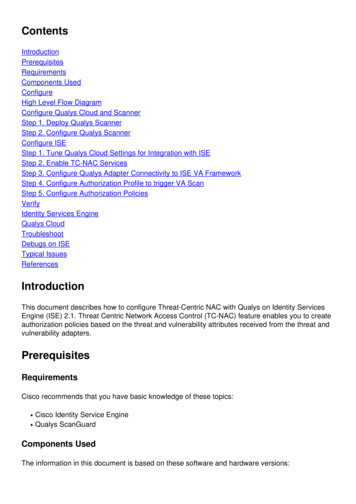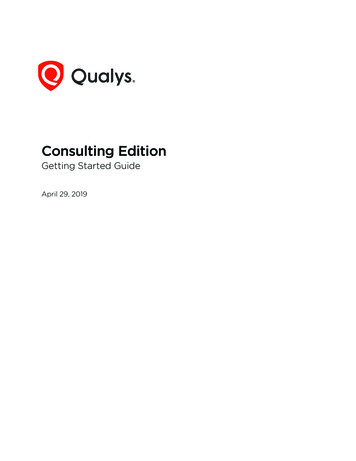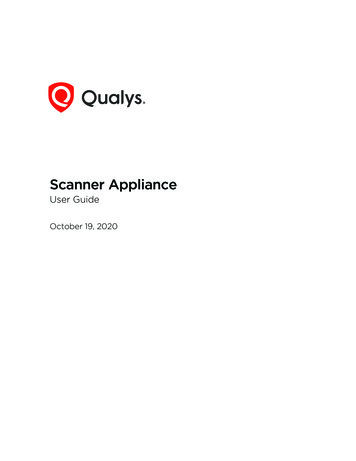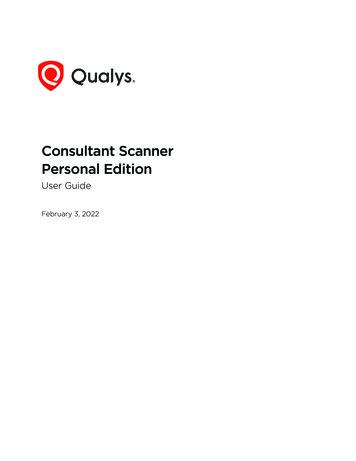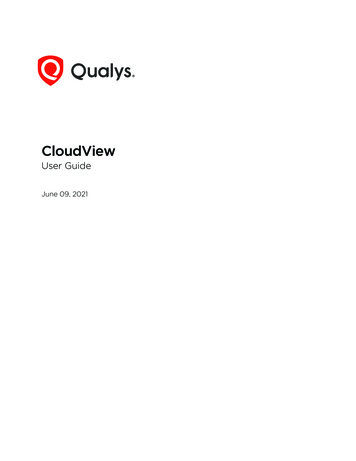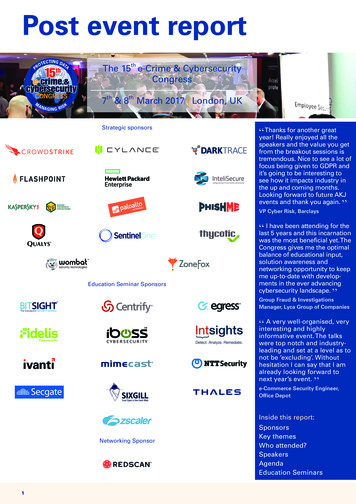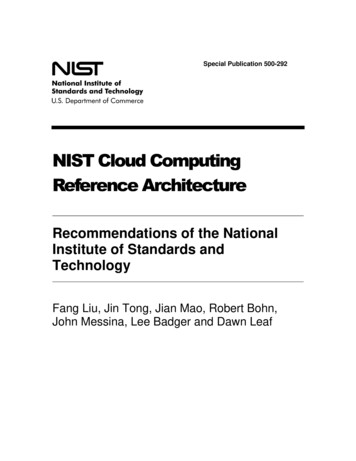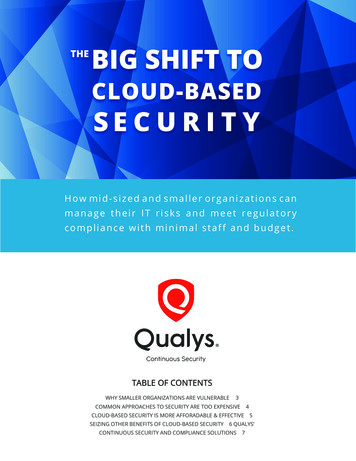
Transcription
GUIDETHEBIG SHIFT TOCLOUD-BASEDSE C U R I T YHow mid-sized and smaller organizations canmanage their IT risks and meet regulatorycompliance with minimal staff and budget.TABLE OF CONTENTSWHY SMALLER ORGANIZATIONS ARE VULNERABLE3COMMON APPROACHES TO SECURITY ARE TOO EXPENSIVE4CLOUD-BASED SECURITY IS MORE AFFORADABLE & EFFECTIVESEIZING OTHER BENEFITS OF CLOUD-BASED SECURITY56 QUALYS’CONTINUOUS SECURITY AND COMPLIANCE SOLUTIONS7
The Big Shift to Cloud-Based SecurityWe’re too smallto be a target for cyber attacksAs a mid-sized or smaller organization, there is a lure of feeling safety inobscurity. “We’re too small to be a target for cyber attacks” is a common refrainused to justify a lax network security posture. Unfortunately, it’s a refrain thatmay come to haunt you. The truth is your company doesn’t have to be agiant global corporation to be in the cross hairs of an attack. Automatedexploits of common vulnerabilities can equally sweep up victims on anyInternet-facing network. As for targeted attacks, smaller companies are oftenhit first precisely because cybercriminals know these organizations have weaksecurity – and may be a steppingstone to connected business partners ora large parent company. The good news is you don’t need to hire a crew ofsecurity experts to effectively manage IT risks and comply with security andprivacy regulations. This paper explains how you can use cloud-based securityto protect your network and ensure compliance without breaking the bank.2
The Big Shift to Cloud-Based SecurityWHY SMALLER ORGANIZATIONS ARE VULNERABLEMedia stories about breaches tend to focus on big exploits such as Target and Heartbleed,which helps foster the illusion of safety for smaller organizations. Eight breaches during 2013alone exposed more than 10 million identities each, according to Symantec’s Internet SecurityThreat Report 2014. But to say, “My company doesn’t offer a sliver of that opportunity to acybercriminal,” misses the key point. The direct and indirect costs of just one effective breachcan bankrupt a mid-to-small sized company. And any sized company connected to the Internetis vulnerable. Here are three reasons why: Cyberthreats and regulations don’t care about business sizeMost attackers don’t care whether they’re targeting a Fortune 25 firm or a smalltown manufacturer with 25 employees. In fact, the number of security incidents withconfirmed data loss affected more small companies than large in 11 of 18 industries,according to the Verizon 2014 Data Breach Investigation Report. These breaches wereoverwhelmingly skewed to smaller companies (defined by Verizon as under 1,000employees) in the Accommodation, Professional, and Retail industries. The commondriver for cyber criminals is to steal and sell data and identities. Regulators are expectingthe same security diligence from mid-sized and small firms as from large corporations.Consider the various data breach disclosure laws. They’re not based on the size of thecompany but the quantity and type of customer records that are breached. While theremay be slight differences in how regulations such as HIPAA, PCI DSS, and others affectmid-sized and even smaller firms, their overarching impact is the same. Software flaws: an ever-growing concernThe number of software vulnerabilities announced daily shows no sign of letting up.According to the Common Vulnerabilities and Exposures List, sponsored by the NationalCyber Security Division of the U.S. Department of Homeland Security, there weremore than 6,100 software flaws reported during August 2013 through July 2014. That’sover 16 newly announced software flaws every day. And these vulnerabilities, whichmake it possible for many forms of malware and attackers to gain entry to protectedsystems, are equally detrimental to businesses large and small. It’s not just end-pointoperating systems, servers, and on-premise software that are at risk. Websites alsopose an enormous risk. According to Symantec’s report, 77% of legitimate websites haveexploitable vulnerabilities and one out of every eight websites has a critical vulnerability.3
The Big Shift to Cloud-Based Security The extended business risk: partners, suppliers, and other stakeholdersAll businesses are under internal and external pressure. Targeted attacks such as spearphishing often aim at smaller organizations. During 2013, 61% of spear-phishing attackswere on organizations smaller than 2,500 people, and 30% hit companies with less than500 people, according to Symantec. The supply chain department was a primary target.Consequently, businesses are demanding to see the security and risk managementplans of those with which they do a significant amount of business. They want to knowabout your disaster recovery and business continuity procedures. They want to knowhow you manage security defenses. And they want to know how you are protecting theirconfidential information.COMMON APPROACHES TO SECURITYARE TOO EXPENSIVEUnfortunately, while the security threats and mandates for regulatory compliance affect allcompanies, it’s the mid-sized and small businesses that often don’t have the right staff or budgetnecessary to cost-effectively fight the threats and maintain compliance. Consider the SMBInformation Protection Survey by Applied Research (published by Symantec in 2010) that showsthat globally small and mid-sized businesses spend two-thirds of their IT management time and 51,000 annually focused on cyber security. That’s twice the amount of time and 27.5 percentmore budget spent than for other areas of computing. That’s simply too high a price for security.Small and mid-sized businesses today arespending 66% of their IT management timefocused on security concerns.Qualys customers in mid-size and smaller organizations are telling a similar story. They say toomuch time is wasted on installing, maintaining, and managing security software and hardware.The biggest portion of this cost is labor.The net result? Security efforts fall short: the tools prove tough to manage, require dedicated4
The Big Shift to Cloud-Based Securityteams of experts, and the resulting reports provide inconsistent and too often inaccurateresults. This means compliance and security objectives go unmet and the software proves tooburdensome to maintain and troublesome to use. Eventually, cumbersome tools go unused.That means vulnerability assessments and remediation go undone, firewall policies go withoutupdates, and flaws on web servers accumulate over time. Eventually, security slips, successfulattacks against the business increase, and regulatory compliance mandates go unmet.CLOUD-BASED SECURITY IS MOREAFFORDABLE & EFFECTIVEAvoiding the cost and the complexity of traditional software is one of the reasons why Softwareas-a-Service (or cloud) has become a mainstream delivery method for security solutions. Keybenefits are low cost, faster-time-to-value and flexibility – without having to buy and maintaindedicated infrastructure.Consider the example of updating security software. Traditionally, updates are performed byindividual organizations, and duplicated for every system and at every business installation.With a cloud solution, the provider centrally updates its software applications and all customersare immediately updated without having to perform any special actions. Cloud deliveryeliminates many of the security issues that plague traditional business-technology systems suchas patching and software misconfiguration. The automation of software updates eliminates asubstantial burden for the IT staff, and reduces the amount of time and expense required tomanage ongoing operations.In its Small and Midsize Business Cloud Trust Study (2013), Microsoft Corporation found half ofrespondents in the U.S. said 'time saved managing' and 'fewer internal IT resources' were thebiggest benefits of cloud services. Significantly, 94% said they have experienced security benefitsfrom cloud solutions that they did not achieve with their on-premises service. About 91% saidorganizational security had improved and 70% said they have reinvested money saved thanks tousing cloud-based services.These business benefits, cost savings and reduction in complexity are fueling the movement ofmany security, risk management and compliance applications into the cloud. Examples rangefrom e-mail management to content-filtering, to disaster-recovery/business continuity, to5
The Big Shift to Cloud-Based Securityvulnerability management and many other processes and technologies. Navigating and reapingthe benefits of this transformation in risk management is one of the most important steps amid-size or smaller business can take to manage ever-spiraling IT costs.The adoption of cloud solutions is driven bythe need to innovate, simplify and cut costs.SEIZING OTHER BENEFITS OF CLOUD-BASED SECURITYAdoption of cloud solutions is driven by the need to innovate, simplify and cut costs. One of thekey distinguishing features of cloud-based security is the lack of equipment or software thatmust be deployed by the end user. All infrastructure is furnished and maintained by the cloudprovider and hosted in secure data centers. This arrangement allows a business to avoid capitalexpenditures and to control ongoing costs. Some of the other benefits of security delivered viacloud solutions for mid-sized and smaller businesses include: No hardware or software requiredSince there is little or no equipment required on-premise and no software agents toinstall that might conflict with other applications, businesses can deploy the cloud-basedservice with ease. All that’s required to operate the solution is a standard web browser. Fast deployment, quality of service and maintenanceCloud computing can be in use within a matter of minutes or hours, and its use of theweb as a transport mechanism to provider data centers actually increases the availabilityof the service to the organization. ScalabilityAllows organizations to immediately respond to new operational requirements withouthaving to deploy additional resources or staff. Expands to works automatically with thelargest global networks. AutomationCloud delivery provides automated updates, automatic enterprise-wide collection and6
The Big Shift to Cloud-Based Securitycollation of network assets and vulnerability data, and automatic reporting and alertingof new vulnerabilities with recommended paths to remediation. The most up-to-date threat informationRecognizing the latest vulnerability, malicious code, or rogue web site requires adedicated team of researchers to characterize the threat and update the securityinspection process. The cloud ensures that the most recent information and functionalityis provided every time the business uses the service.QUALYS’ CONTINUOUS SECURITYAND COMPLIANCE SOLUTIONSRecognized as the leading provider of continuous security and compliance managementsolutions, Qualys enables organizations of all sizes to easily and cost-effectively ensure that theirbusiness technology systems remain secure and within regulatory compliance. Qualys makes itpossible for businesses to strengthen the security of their networks and applications, as well asconduct automated security audits that ensure regulatory compliance and adherence to internalsecurity policies.Qualys delivers these solutions through a single Software-as-a-Service platform: Qualys CloudPlatform. All Qualys continuous security and compliance solutions can be deployed within hoursanywhere around the globe, providing an immediate view of your organization’s network assets,network and application security posture, vulnerability management and remediation workflow,and compliance with regulations and organizational policy. As a result, Qualys is the most widelydeployed continuous security and compliance solution in the world, performing more than onebillion audits per year.QualyssolutionsincludeEnterprise for global organizationsExpress for SMEsExpress Light for SMBsConsultant for auditors and consultantsPrivate Cloud Platform for MSSPs, enterprises and government agenciesFor more information visit: http://qualys.com7
The Big Shift to Cloud-Based SecurityQUALYS EXPRESSEverything a mid-sized business needs to quickly discover network and application security risksand ensure policy compliance.Qualys Express uses the power of the cloud to simplify your IT security and lower the cost ofcompliance. It helps you keep track of your networks, computers and web applications, andaccurately tells you where they’re vulnerable so that you can fix problems before attackers findyou. It also automates many of the tedious parts of complying with regulations such as PCI andHIPAA so that you can spend more time growing your business and less time worrying about it.Core components of Qualys Express include:Asset Management Discover rogue devices & web applications Automatically identify, tag and organize assets Dynamically select assets for scanning or reportingSecurity Find & track vulnerabilities in network servers & devices, and web applications Report security trends across systems & time Identify needed patches Prioritize & manage remediation Predict impact of Zero-Day attacks Interactively view security posture throughout your network Feed actionable security data to SIEM, GRC, ERM, WAF and moreCompliance Verify that systems implement required controls (such as password enforcement andinformation access policies) Test system configurations against golden images or baseline standards such as USGCB Test and submit PCI certification online Check for compliance with HIPAA, SOX, GLBA, Basel II, and more Automate procedural questionnaires for employees, vendors and partners Centralize collection of assessment evidence files8
The Big Shift to Cloud-Based SecurityQualys, Inc. – Headquarters1600 Bridge ParkwayRedwood Shores, CA 94065 USAT 1 (800) 745.4355Qualys is global company with offices around the world.To find an office near you, visit, http://www.qualys.com Qualys and the Qualys logo are proprietary trademarks of Qualys, Inc. All other products or names may be trademarks of their respective companies. 8/149
As a result, Qualys is the most widely deployed continuous security and compliance solution in the world, performing more than one billion audits per year. Enterprise for global organizations Express for SMEs Express Light for SMBs Consultant for auditors and consultants Private Cloud Pl
